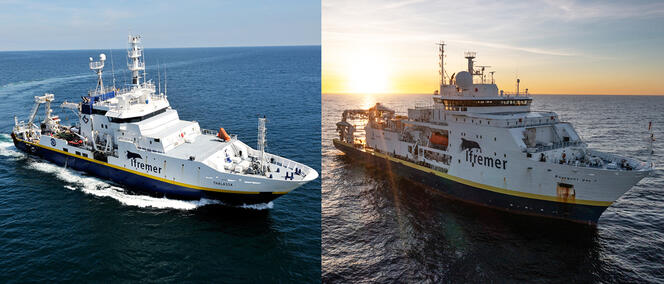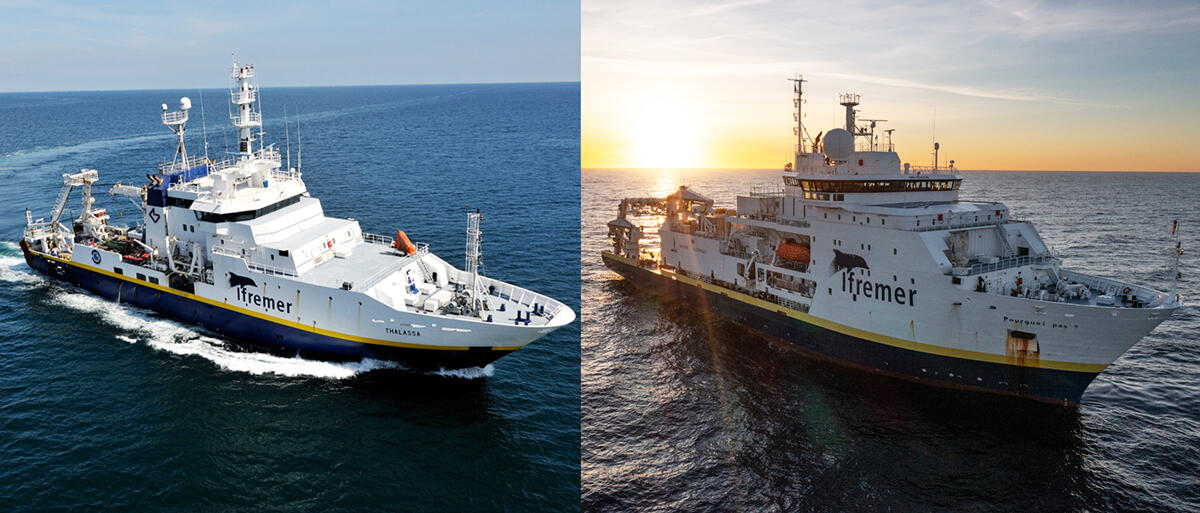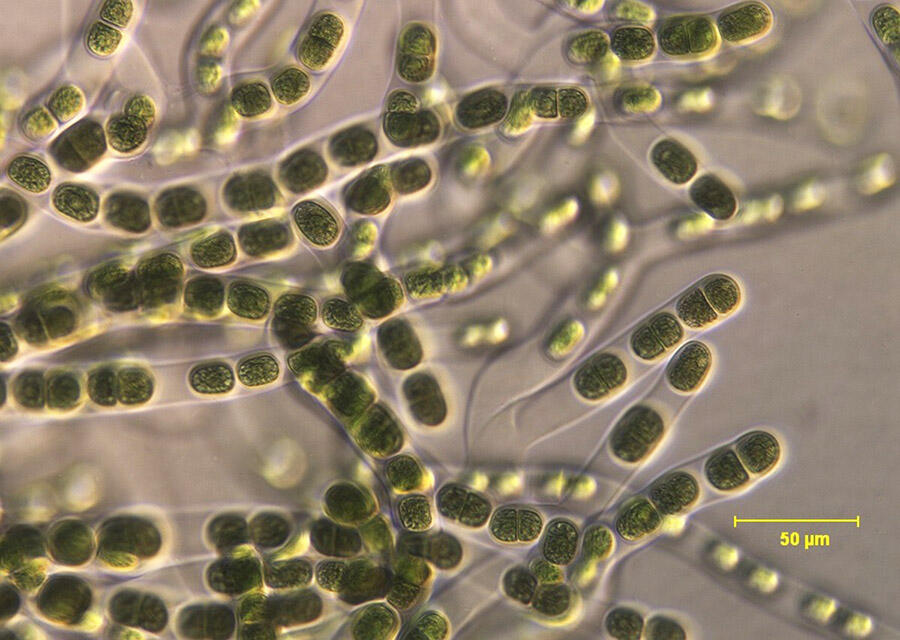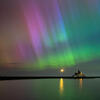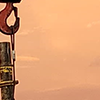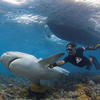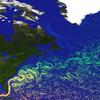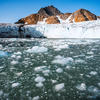You are here
Boarding the ships of the APERO campaign
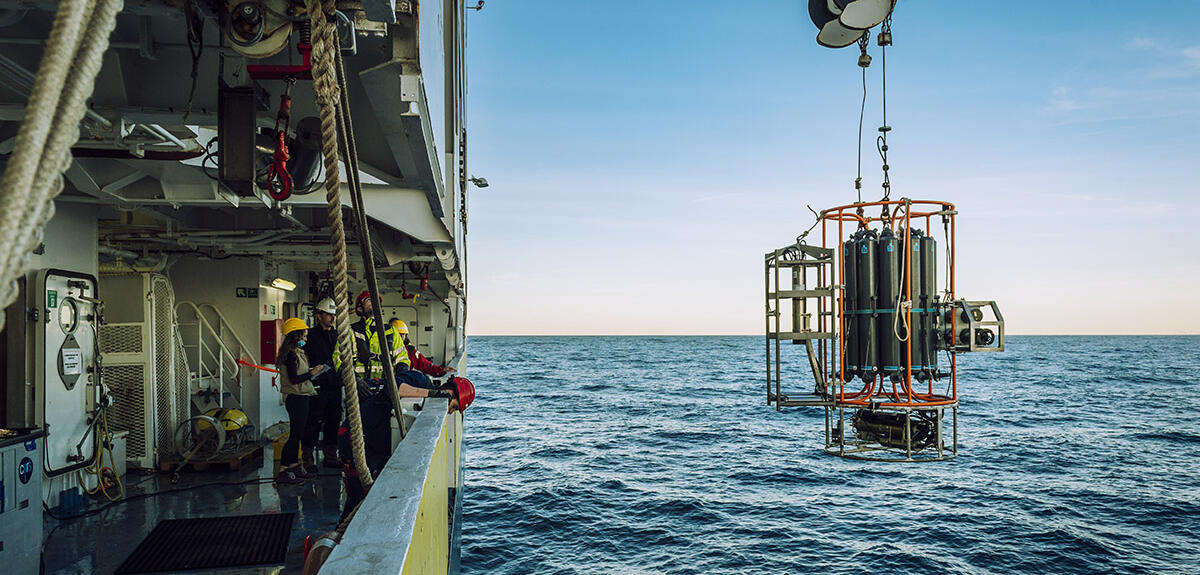
Brittany, June 2023. Here in this westernmost point of France, a new scientific expedition is about to get under way. Moored in the port of Brest, two ships belonging to the French Oceanographic Fleet are preparing to set sail for the North-East Atlantic, in one of the most important oceanographic campaigns of recent years, dubbed APERO.1 Co-directed by three CNRS researchers, Laurent Memery, from the Laboratory of Marine Environmental Sciences (LEMAR) in Brest,2 Lionel Guidi, from the LOV oceanography laboratory in Villefranche-sur-Mer,3 and Christian Tamburini, from the Mediterranean Institute of Oceanography (MIO)4 in Marseille (both in southeastern France), this international campaign brings together 120 scientists from some fifteen French and international laboratories working in an impressively wide range of disciplines, including vortex physics, molecular biology, modelling, ecology and geochemistry.
Sixty-five of them set sail on 3 June on the Thalassa and on 6 June on the Pourquoi Pas?, for a 45-day long voyage in an area 570 km southwest of Ireland located around the UK's PAP sustained scientific observatory.5 The aim is to improve their understanding of the fate of carbon in the deep ocean and thus attempt to unlock the secrets of the biological pump. Marine biology plays a key role in the natural carbon cycle, sequestering large amounts of CO2 in deep sea waters. Although this mechanism, which gives the ocean a key role in regulating the climate, has long been recognised, the details of these processes are still poorly understood, especially in the mesopelagic zone, at depths between 200 and 1,000 metres below the surface.
Understanding carbon exchanges between the surface and the deep sea
At the surface of the ocean, atmospheric carbon dioxide is absorbed by phytoplankton during photosynthesis, a process that incorporates carbon into living organisms. The resulting particles sink into the depths, where they are partially oxidised, dissolved, and broken down, especially by bacteria. Some of this material will be stored in sediments for several thousand years. “Every year, around 10.2 gigatonnes of carbon are exported from the surface to depths below 200 metres,” Memery explains. “Without this mechanism, the Earth's atmospheric carbon content during the pre-industrial period would have been about 40% higher, at 400 ppm (parts per million), instead of 280 ppm.” However, as Tamburini points out, “there is a mismatch, which scientists have so far been unable to explain, between, on the one hand, the amount of organic carbon produced by photosynthesis and transferred to the deep ocean, and, on the other, the metabolic demand for carbon in the water column”.
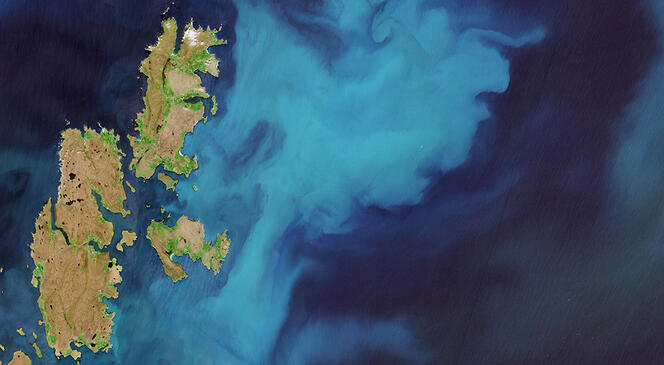


To shed light on the dynamics, processes and players underlying this puzzling discrepancy, APERO's scientists will deploy an ambitious strategy of sampling and observations in the mesopelagic zone. The timing is perfect, since particulate carbon export to the deep ocean is at its peak during the summer bloom in the North-East Atlantic. The exploration zones will also be carefully chosen. Since the oceans are highly variable both spatially and temporally, Memery will work onshore, using satellite data and the outputs of operational models to precisely select, in real time, the most suitable areas among ocean eddies.
One of the main goals of the APERO mission is to understand the impact on processes in the deep ocean of these 100-300 km wide high-energy zones at the surface, via the specific ecosystems that form on their fronts, on a scale of several tens of kilometres6. Using day-to-day strategies drawn up on land and relayed in real time to the ships in the fleet, the Thalassa will carry out a regional survey of genetics, trawling, acoustics and molecular biology, while the Pourquoi Pas? will undertake five to six longer surveys aimed at studying in detail the biological processes that impact settling matter.
Drifting moorings will trap particles for five days before being retrieved at the surface, and rosette samplers will collect marine snow, while underwater gliders packed with sensors will drift with the currents, at speeds of around 25 km per day. In addition, autonomous Argo profiling floats will also be deployed, equipped with optical sensors or with cameras that can identify, with high precision, all the flows of matter and populations of organisms present, using pattern recognition algorithms. Nets with different mesh sizes will also sample nekton of various dimensions, at carefully selected water depths. The scientists even have instruments at their disposal to bring organisms up to the surface at constant pressure, thus limiting their stress and, accordingly, possible bias caused by changes in conditions.
Mapping biodiversity The APERO mission will also draw on the expertise acquired during the campaigns carried out on the French scientific research schooner Tara to undertake some highly advanced molecular biology. As Memery explains, “by identifying all the organisms in the water column, and mapping this biodiversity thanks to the genomes involved, via the analysis of their DNA and RNA, we will be able to determine the role of a number of functions associated with certain families of bacteria”. This holistic strategy is highly innovative. “In terms of size, and on human scales, it's a bit like observing an ant and the Himalayas simultaneously,” Guidi points out. This survey will make it possible to single out organisms ranging from bacteria and viruses to large plankton, micronekton and mesopelagic fish (myctophids). “We are now in a position to deploy all these sophisticated technological resources to explore the mesopelagic zone, which wouldn't have been possible even ten years ago. That's why the part of the ocean deprived of light, known as the dark ocean, is the least studied and, therefore, least known ecosystem on the planet, even though it's the largest,” Guidi concludes.
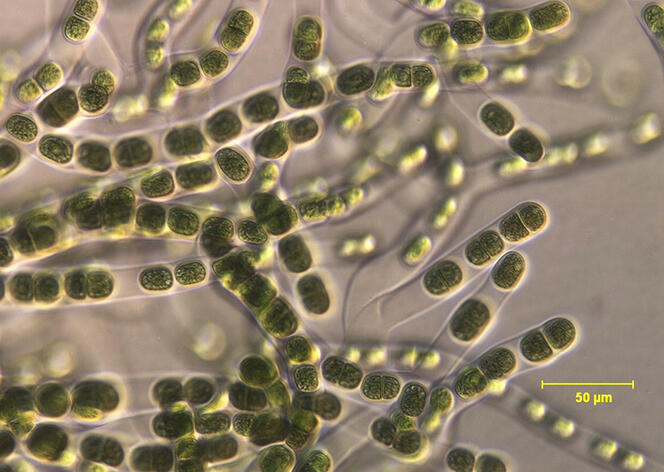
“It was high time we got there,” confirms Memery. “Developments in observation methods (autonomous platforms, high-frequency measurements, acoustics, imaging, molecular biology, etc.), as well as advances in modelling (computer power, the ability to handle complexity, and artificial intelligence), are finally making it possible to explore the mesopelagic zone.” There is little doubt that the improvement in the understanding and models that the APERO mission data point to will eventually help to assess the impact of climate change on the ocean's ability to absorb carbon.
On 8 June, the day after the departure of the fleet's two ships, World Oceans Day served as a reminder of the essential role of the blue lungs of our planet: covering 70% of the Earth's surface, the ocean absorbs part of its CO2 and produces half its oxygen. Within the context of the Decade of Ocean Science for Sustainable Development (2021-2030), the objective of the international JETZON (Joint Exploration of the Twilight Zone Ocean Network) consortium, of which the APERO mission forms part, is “to provide the scientific understanding necessary to inform a sustainable approach to the management and conservation of the Twilight Zone7 ecosystem”.
- 1. The APERO campaign, supported by the CNRS and the French National Research Agency (ANR), stands for “Assessing marine biogenic matter Production, Export and Remineralization: from the surface to the dark Ocean”.
- 2. CNRS / Université de Bretagne Occidentale / IRD / IFREMER.
- 3. CNRS / Sorbonne Université.
- 4. CNRS / Aix-Marseille Université / IRD / Université de Toulon.
- 5. The Porcupine Abyssal Plain Sustained Observatory (PAP-SO) is a permanent UK station (48°50’N 16°30’W), at a depth of 4,850 m, operated since 1985 by the National Oceanography Centre (NOC), Southampton. For nearly 40 years, its sensors have been recording time series data, providing key information for the assessment of long-term changes in the ocean and its ecosystems.
- 6. The ocean is full of eddies, identifiable by their physical signature and water height. Warm eddies form bumps, while cold eddies form troughs. This phenomenon is comparable to the atmosphere’s cyclones and anticyclones, except that water is much denser than air, which explains the difference in scales.
- 7. The Twilight Zone refers to the dimly lit zone of the ocean between 200 and 1,000 m below the surface, i.e. the mesopelagic zone.
Author
Working at the daily Ouest-France since 2003, Gaël Hautemulle is in charge of sea-related content for the Brest-based editorial office.


